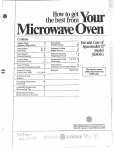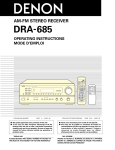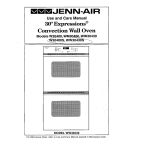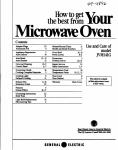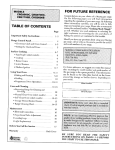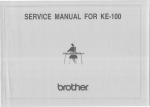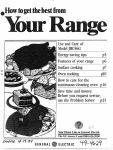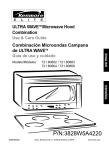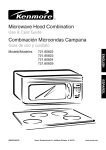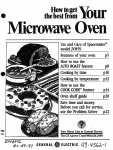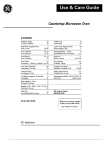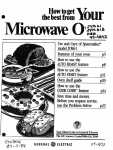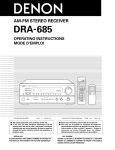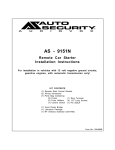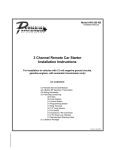Download GE JEM31F User's Manual
Transcript
How toget the bestfrom Mcrowave Oven Use and Care of Spacemaker Ir" model JEM31F Features Roast P5 Auto PI0 Defrost Auto PI2 Shelf Guide Questions? Use the Problem Solver Your Direct Line to General Electric The GE Answer Cente; 800.626.2000 . Contents Help us help you. Before Using Your Oven . . . . . . . 2 Safety Instructions . . . . . . . . . .3,4 Features of Your Oven . . . . . . . . . S Your Touch Control Panel . . . . . .6 Set the Clock . . . . . . . . . . . . . . .. 6 MinuteBecond Timer . . . . . . . . .7 Cooking by Time . . . . . . . . . . . .. 8 Cooking by Temperature . . . . . . .9 Automatic Roasting & Guide . . . . . . . . . . . . . . . . .lo, 11 Automatic Defrosting . . . . . . 12, 13 Defrosting by Time. . . . . . . . . ..I4 To Remove the Oven from Cabinet Mount . . . . . . . .15 Shelf Guide . . . . . . . . . . . . . .16, 17 Care and Cleaning . . . . . . . . . . .I8 Grounding Instructions . . . . . . .19 Use of Extension Cords . . . . . . .19 The Problem Solver . . . . . . . . . .20 IfYou Need Service . . . . . . . . . .21 Warranty . . . . . . . . . . .Back Cover Before using your oven, read this book carefully. hlicrowaving Tips Make sure all cookware used in your microwave oven issuitable for microwaving. Most glass casseroles, cooking dishes, measuringcups, custard cups, pottery or china dinnerware which does not have metallic trim or glaze with a metallic sheen canbe used. Some cookware is labeled “suitable for Micmving:’ If you are unsure, use thisdish test: Measure 1 cup water in a glass cup. Place in oven on or beside dish. Microwave 1-1 ‘/z minutes at HIGH. If water becomes hot, dishis micrclwsve . safe. If dish heats, it should not be used for microwaving. Paper towels, wax paper, and plastic wrap can be used to cover dishes in order to retain moisture and prevent spattering. Some microwaved foods require stirring, rotating, or rearranging. Check your Cookbook. Steam builds up pressure in foods which aretightly covered by a skin or membrane. Pierce potatoes, egg yolks and chicken livers to prevent bursting. It is intended to help you operate and maintain your new Microwave Oven properly. Keep it handy for answers to your questions. If you don’t understand something or need more help, write (include your phone number): Consumer Affairs General Electric Company Appliance Park Louisville, KY 40225 Write down the model and serial numbers. You’ll find them on a label inside the oven. These numbers are alsoon the Consumer Product Ownership Registration Card that came with your Microwave Oven. Before sending in this card, please write these numbers here: Model Number Your supplier is responsible for registering you as the owner. Please check with your supplier to be sure he has done so; also send in your Consumer Product Ownership Registration Card. If you move, or if you are not the original purchaser please write to us, stating model and serial numbers. This appliance must be registered. Pleasebe certain that it is. Write to: General Electric Company Range Product Service Appliance Park Louisville, KY 40225 If you received a damaged Oven.. . Immediately contact the dealer(or builder) that sold you the Oven. Save time andmoney. Before you request service.. . check the Problem Solver on page 20. It lists minor causes of operating problems that you can correct yourself. Serial Number Use these numbers in any correspondence or service calls concerning your Microwave Oven. Be sure your Microwave Oven is registered. It is important that we know the location of your Microwave Oven should a need occur for adjustments. Optional Accessories available at extra cost from your General Electric supplier. JX8F Installation Kit converts this oven to a built-in wall oven. WMSF Installation Kit allows this oven to be mountedon a wall. When unpacking your microwave oven.. . you should find an installation package thatcontains installation instructions, a template, and installation hardware for underthe-cabinet mounting. If missing, contact your supplier. All These Things Are Normal with your. Microwave Oven: 2 ..... PRECAUTIONS TO AVOID f’- POSSIBLE EXPOSURE TO EXCESSIVE MICRQWAVE ENERGY - ’ -- .,, (a) Do Not Attempt to operate this oven with the door open since open door operation can resultin harmful exposure to microwave energy. It is important not to defeat or tamperwith the safety interlocks. (b) Do Not Place any object between the oven front faceand the door or allow soil or cleaner residue to accumulate on sealing surfaces. (c) Do Not Operate the oven if it is damaged. It is particularly important that the oven doorclose properly and that thereisno damagetothe: ( I ) door (bent) (2) hinges and latches (broken or loosened) (3) door seals and sealing surfaces. (d) The Oven Should Not be adjusted or repaired by anyone except properly qualified service personnel. IMPORTANT SAFETY INSTRUCTIONS Read all instructions before using this appliance. When using electrical appliances basic safety precautions should be followed, including the following: Do not operate this appliance if it has a damaged power cordor plug, if it is not working properly, or if it has been damagedor dropped. WARNING-TO reduce the riskof burns, electric shock, See door surface cleaning fire, injuryto persons or exposure instructions onpage 18. to excessive microwave energy: This appliance shouldbe Use this appliance only for its serviced only by qualified service intended useas described in this personnel. Contact nearest manual. authorized service facility for examination, repairor adjustment. Read and follow the specific “PRECAUTIONS TO AVOID As with any appliance, close POSSIBLE EXPOSURETO supervision is necessary when EXCESSIVE MICROWAVE used by children. ENERGY” at left. To reduce the risk of fire in This appliance must be grounded. the oven cavity: Connect onlyto properly grounded -Do not overcook food. Carefully outlet. See “GROUNDING attend applianceif paper, plastic, INSTRUCTIONS” on page19. or other combustible materials are placed inside the ovento facilitate For best operation, plug this cooking. appliance into itsown electrical outlet, to prevent flickering of -Remove wire twist-ties from lights, blowing of fuse or tripping paper or plastic bags before of circuit breaker. placing bag in oven. -Do not use your microwave Install or locate this appliance oven to dry newspapers. only in accordance with the provided installation instructions. -Paper towels, napkins and wax paper. Recycled paper Be certain to place the front surface of the door three inches orproducts can contain metalflecks more back from the countertop which may cause arcingor ignite. Paper products containing nylon edge to avoid accidental tipping or nylon filaments shouldbe of the appliance in normal usage. as they may also ignite. avoided, (If used on countertop.) -Do not operate the oven while Do not coveror block any empty to avoid damage to the openings on the appliance. oven and the danger of fire. If Do not useoutdoors. by accident the oven shouldrun empty a minute or two, no harm Do not immerse power cord or is done. However, try to avoid plug in water. operating the oven empty atall Keep power cord away from times-it saves energy and heated surfaces. prolongs the lifeof the oven. Do not let power cord hang over edge of table or counter. 3 IMPORTANT SAFETY INSTRUCTIONS(continued) -Do not pop popcorn in your microwave ovenunless in a special microwave popcorn accessoryor unless you use popcorn labeled for use in microwave ovens. -If materials insideoven should ignite, keep oven door closed,turn oven off, and disconnect power cord, or shut off power at fuseor circuit breaker panel. Some products suchas whole eggs and sealed containers-for example, closed glass jars-may explode and should not be heated in this oven. Avoid heating baby food in glassjars, even without theirlids; especially meat and egg mixtures. Don’t defrost frozen beverages in narrow necked bottles (especially carbonated beverages). Even if the container is opened, pressure can build up. This can cause the container to burst, resulting in injury. Use metal onlyas directed in Cookbook. Foil strips as used on meat roasts are helpful when used as shown in Cookbook. TV dinners may be microwaved in foil trays less than3/4”high; remove top foil cover andreturn tray to box. When using metalin the microwave oven,keep metal (other than metalshelf) at least 1 inch away from sides of oven. Cooking utensilsmay become hot because of heat transferred from the heated food. Potholders may be neededto handle the utensil. Sometimes, the oven floor Be can become too hot to touch. careful when touching the floor during and after cooking. Foods cooked in liquids(such as pasta)may tend to boil over more rapidly than foods containing less moisture. Should this occur, refer to page 18 for instructions on how to clean the inside of the oven. Thermometer-Do not use a thermometer in food you are microwaving unless the thermometer is designedor recommended for usein the microwave oven. Remove the temperature probe If from the oven when not in use. you leave the probe inside the oven without insertingit in foodor liquid, and turn on microwave energy,it can createelectrical arcing in the oven and damage oven walls. Plastic utensils-Plastic utensils designed for microwave cooking are very useful, but should be used carefully. Even microwave plastic may not be as tolerantof overcooking conditionsas are glass or ceramic materials andmay soften or char if subjected to short periods of overcooking. In longer exposures to overcooking, the food and utensils could ignite. For these reasons: 1) Use microwave plastics only and use them in strict compliance with the utensil manufacturer’s recommendations. 2) Do not subject empty utensils to microwaving. 3) Do not permit children to use plastic utensils without completesupervision. When cooking porkfollow our directions exactly and always 170°F. cook the meat to at least This assures that, in the remote possibility that trichinamay be present in the meat, it will be killed and meat will be safe to eat. Boiling eggs is not recommended ina microwave oven. Pressure can buildup inside the egg yolk and may cause it to burst, resulting in injury. 4 Foods with unbroken outer “skin” such as potatoes, sausages, tomatoes, apples, chicken livers and other giblets, andegg yolks (see previous caution) should be pierced to allow steam to escape during cooking. “Boilable” cooking pouches and tightly closed plastic bags should be slit, pierced or vented as directedin Cookbook. If they are not, plastic could burst during or immediately after cooking, possibly resulting in injury. Also, plastic storage containers should be at least partially uncovered because they form a tight seal. When cooking with containers tightly covered with plastic wrap, remove covering carefully and direct steam away from hands and face. Spontaneous boiling-Under certain special circumstances, liquids may start to boil duringor shortly after removal from the microwave oven.To prevent burns from splashing liquid,stir the liquid briefly before removing the container from the microwave oven. Use of the DOUBLE DUTY” shelf accessory. -Remove the shelf from oven when not in use. -Do not store or cook with shelf on floor of oven. Product damage may result. -Use potholders when handling the shelf and utensils. Theymay be hot. -Do not use microwave browning dish onshelf. The shelf could overheat. -Be sure that the shelf is positioned properly inside the oven to preventproduct damage (see page 16). SAVE THESE INSTRUCTIONS Features of Your Oven 0 Cooking Complete Reminder (For all AUTO ROAST codes except code 6, AUTO DEFROST, COOK'N WATCH, TIME COOK and TIME DEFROST cycles) To remind you that you have foodin the oven, theoven willbeep once minute a until you either openthe oven door ortouch the CLEARIOFF pad. Q 1. Door Latches. 2. Door Screen. Metal screen permits viewingof foods and keeps microwaves confined inside oven: 3. Oven Vent. 4. Model and Serial Numbers. . 5. Oven Interior Light turns on 8. Touch Control Panel and when the door is op&ed or when the oven is operating. Display. See next page for instructions. 6. MICROTHERMOMETER" Temperature Probe. Use with AUTO ROAST or TEMP COOK/HOLD function only. 7. DOUBLE-DUTY" Shelf. Lets you microwave severalfoods at once. (See Safety Instructions and pages 16 and 17 for special instructions.) When this shelf is not in use, please remove from the oven. 9. Door Latch Release. Press latch 5 release bar at indent to open door. Door must be securely latched for oven tooperate. 10. Auto Roast and Auto Defrost Guides. Contain cooking information for the Automatic Roasting function (seepage 10) and defrosting information for the Automatic Defrosting function (see page 12). I&tr Touch Control Panel 9. TEMP COOK/HOLD.Use The Touch Control Panel allows you to set the ovencontrols electronically with the touch of a finger. It’s designed to be easy to use and understand. the temperature probeto cook by using a preset temperature. Once oven reaches preset temperature, it switches to HOLD setting and maintains that temperature until you touch the CLEAR/OFF pad. (See page 9.) 1. TIME COOK I & 11. Microwave for a preset amount of time using automatic Power Level 10 (HIGH), (orchange power level after entering cooking time. See paye 8.) 10. MIN/SEC TIMER.This feature uses no microwaveenergy. It functions as akitchen timer, as a holding period after Time Defrost or as a delay timer before Time Cook 1 & 11, Temp Cook/Hold or Auto Roast. (See page 7.) 2. TIME DEFROST. Gentle, gcncrally uniform thawing at automatic Power Level 3 (LOW), (or change power level after entering defrosting time. See page 14.) ll. COOK ’N WATCH. Use this pad for short-term cooking which automatically turns oven off after 3 minutes. (See page 8.) 3. POWER LEVEL. Touch this pat! hclorc cntcring another Power Lcvcl number if you want to change from ;tutomatic Power Level IO ( H I G H ) tor cooking or Power Lcvcl 3 (LOW) for defrosting. 12.CLOCK. Touch this pad to enter time of day or check time of day while microwaving. To set clock, first touch CLOCK pad and then enter timeof day. For example, if time is 1:30, touch number pads 1,3, and 0 and 1:30 will appear in display. Touch START pad. To reset or change time, simply repeat above process. 4. NlJRIBI4:K PADS. Touch these pads t o cntcr cooking/defrosting timc. Power Lcvcl, time of day. A u t o Roast Codcs and Auto Defrost weights. 5. RIIN. Use with numbcr pads to cntcr wholc minutes. For example, ti)r 4 minutcs touch 4 and M I N . 13. CLEAR/OFF. When touched. it shuts off the oven and erases all 6. START. After all sclections are made. touch this pad to start oven. settings (except time of day). 14. AUTO DEFROST. Touch this pad and then the number pads for the desired food weight. The oven automatically sets power levels and defrosting time. (See pages 12 and 13.) 7. AUTO ROAST. Insert probe, touch this pad. and desired number pad for Code to slow-cook or temperature cookmeat with automatic preset program. (See pages 10 and 11.) 8. DISPLAY. Displays time of day, time counting down during cooking functions, power level, Auto Roast and Auto Defrost Codes, cooking mode and instructions. “PROBE” Appears On Display: Probe has been forgotten when AUTO ROASTor TEMPCOOK/ HOLD function is being used. Probe is not securely seated in oven wall receptacle. Program Cooking Use your Touch Control Panel to Auto Roast or Auto Defrost with the oven automatically setting the times and power levelsfor you, Time Defrost, Time Cook and Cook’N Watch with choice of Power Levels from 1 (low) to 10 (high), time kitchen tasks with the Min/Sec Timer. and set the clock. 6 Create your own programs to suit your individual cooking style. For example: use the Min/Sec Timerto delay the start of Auto Roast, Temp Cook/Hold or Time Cook I & I1 or program a hold time between Time Defrost and Time Cook I & 11. (See page 7.) Set Time Cook I & I1 for a two-stage program using different times and Power Levels.(See page 8.) How to Use the Nlinute/Second Timer : -’ . The MIN/SEC TIMER has three timing functions: It operates as a minute timer. It can be setto delay cooking. It can beused as a hold setting after defrosting. The MIN/SEC TIMERoperates without microwave energy. Step I: Take casserole from freezer and place in oven. How to Time a 3-Minute Phone Call Step 2: Touch TIME DEFROST pad. 1. Touch MIN/SEC TIMER pad. The display shows :O and “ENTER TIME” flashes. 2. Touch number pad 3 and MIN (for 3 minutes and no seconds). Display shows 3:OO and “TIME” flashes. 3. Touch START. Display shows “TIME” and time counting down. 4. When time is up, oven signals, flashes ‘‘End,” and display shows t imc of day. --, ’.-. I’rogra~n~ning a €IOI,D TINlE Step 8: Touch STAFT.“DEF TIME” and 15:OO counting down show on display. As each function is automatically performed oven display shows instructions entered and the function. The display shows :O and “POWER 31’ “ENTER DEF TIME” flashes. Step 3: Touch pads I, 5 and MIN for 15 minutes defrosting time. 15:OO appears on display. (Defrosting is automatically set on Power Level 3 but can be changed by touching the POWER LEVEL pad and the desired power level.) The Minutc/Sccond Timercan also be used to program “hold time” between microwave cooking functions. The time can range from one second to 99 minutes and 99 seconds. A HOLD. o r “standing” time may be found in some of your own recipes or Cookbook. I’rogramming Delayed Cooking To delay cooking up to 99 minutes, touch TIME COOK I & 11. TEMP COOKIHOLD or AUTO ROAST and enter cook timeor temp. Touch MINISEC TIMER and enter number of minutes to delay cooking. Touch START. Timer will count down to zero and cooking will begin. When delaying temperature or Auto Roast cooking, be sure probe is in food before pressing START. How to Time Defrost, Hold and TimeCook Let’s say you want to defrost a frozen casserole for 15 minutes, hold for 10 minutes and then TimeCook for 25 minutes. Here’s how to do it: Step 7: Touch 2 , 5 and MIN for twenty-five minutes of cooking time. “COOK TIME” flashes and 2 5 9 0 and “POWER 10’ appear on display. Step 4: Set standing or hold time by touching MIN/SEC TIMER. The display shows :O and “ENTER TIME” flashes. Step 5: Touch 1,0 and MIN to hold for ten minutes. 1O:OO appears on display and “TIME” flashes. Step 6: Touch TIME COOK I & I1 pad. The display shows :O and “POWER 10:’ “ENTER COOK TIME’’ flashes. 7 Step 9: When time is up, the oven signals and flashes “End.” Questions andilnsww; Q. What will happen if I accidentally reverse my defrost, hold and cookinstructions? A. The oven will automatically rearrange your program. Defrosting will always come first, then hold. and then the cooking function. Q. Can I defrost and hold only? A. Yes. Sometimes you may only want to defrost a food, hold it. and cook it later. All you nced to do is program in Defrost and amount of time. Then program Hold and the amount of time. Be sure to put the thawed dish in the refrigerator promptly. NOTE: Let foods remain at room temperature only as long as safe. Times will vary. Q. I programmed my oven for a specific defrosting time but it defrosted longer than necessary What happened? A. When instructions conflict, the oven carries out the last instruction. You may have set the oven to Defrost for 4 minutes, Hold/Time for 2 minutes. and then Defrost for 6 minutes. In this case, the oven would Defrost for 6 minutes and Hold/Time for 2 minutes. TIME COOK I & I1 allows you to microwave for a preset amount of time using automatic Power Level 10, or change Power Level automatically. Power Level 10 (HIGH) is recommended for most cooking, but you may change this for more tlexibility. See your Cookbook. To become better acquainted with timc cooking, make a cupof coffee by tollowing the steps below. To Use Cook ’N Watch Step 4: Touch START. “COOK TIME:’ “POWER 10;’ and time counting down show on display. Step 5: When timeis up, the oven signals and flashes “End,” Oven, light and fanshut off. Step 6: Open the door. Using the TimeCook I1 Feature Step 1: Fill a cup2/3 full of water and add 1 teaspoon of instant coffee and stir to dissolve. Use a cup that has no metal decoration and is microwave safe (refer to Microwaving Tips on page 2). Place cup in oven and close door. Step 2: Touch TIME COOK I & I1 pad. Display shows :O and “POWER IO:’ “ENTER COOK TIME’ flashes. Step 3: Select your time. Touch 1. 3 and 0 for one minuteand 30 seconds. Display shows 1:30 and “COOK TIME” flashes. If another power level isdesired, touch POWER LEVEL pad and desired number, although Power Level 10 (HIGH) is preferred for this cup of coffee. With the Time Cook I1 feature, you can set two time cooking functions within one program. Thiswould be ideal if you desired to change power levels during your cooking operations. The following is anexample of how to change power levels using Time Cook 11. Step 1: Repeat Steps 1, 2 and 3. Step 2: Touch TIME COOK I & 11. Step 3: Set your time. Step 4: To change the power level, touch POWER LEVEL pad and desired number for new power level. Step 5: Touch START. Step 6: “POWER 10” is displayed and “COOK TIME I” counts down. Step 7: At the end of “COOK TIME I” thenext selected power level is displayed and “COOK TIME 11” is shown counting down. Step 8: When time is up, the oven signals and flashes “End,” The oven, light and fan shut off. Step 9: Open the door. Cook ’N Watch The Cook ’N Watch feature is a short-term cooking program which automatically turns theoven off after 3 minutes. It’s ideal for melting cheese on food or other quick cooking operations where you want to stop cooking at just the right time. 8 e Step 1: Touch COOK ‘N WATCH. “COOK ’N WATCH” and “POWER 10” are displayed and “START” flashes. Step 2: Touch START. “Cook ‘N Watch” and time counting up to 3 minutes are displayed. Power Level 10 is automatically set in oven but another power level can be selected. Step 3: Open the door ortouch the CLEAR/OFF pad to stop cooking. The oven will automatically signal, flash “End” and shut off at the end of 3 minutes. Questions and Ansvws Q. I set my oven for the time called for in the recipe, but at the end of thetime allowed, my food wasn’t done. What happened? A. Since house power varies due to time or location many Time Cook recipes give you atime range to prevent overcooking. Set the oven for minimum time, test the food for donencss, and cook your food a little longer, if necessary. Q. I touched the number pads and selected my power level. When I touched START, however, my oven didn’t come on.Why not? A. The TIME COOK I & I1 pad must be touched before setting the number padsor else your oven will not begin cooking. Q. I want to cook on a power level other thanHIGH. What do I need to do? A. To change the power level, touch the POWER LEVEL pad. “ENTER POWER’ flashes on the display panel. Enter new number. Q. Can I interrupt my Time Cook function to check thefood? A. Yes. To resume cooking, simply close the door andpress the START pad. The timermust be reset for cooking to resume unless time is remaining on timer. -.:hI ;-. . Cooking by Temperature /-. ; x-* 12- Internaltemperature is the best test of doneness for many foods. How to TempCook a Rolled Beef RibRoast to Medium Use TEMP COOK/HOLD to cook a variety of foodsto your desired finished food temperature. The TIMECOOK I & I1 setting is preferred for batters, doughs, frozen foods and foods which are difficult to cook precisely with the probe. “TEMP COOK/HOLD” takes the guesswork out of cooking because the oven automatically signals with four beeps when the food reaches the preset temperature. The Hold feature will maintain this temperature for up to twelve hours or until you touch the CLEAR/OFF pad. Note: Oven automatically switches to “Hold” when preset food tenlpcrature is reached. Step 1: Insert temperature probe into roast and attach probe securely in oven wall. Close the door. HANDLE CABLE ~ .’ The temperature probeis a food thermometer that gauges the internal temperature of your food; it must be used when using “TEMP COOK/HOLD” or “AUTO ROAST:’ To use your probe properly. follow directions on page 10. Step 2: Touch TEMP COOWHOLD. “F” and “POWER IO” are displayed and “ENTER TEMP” flashes. Step 3: Touch 1,2,5 for 125°F. “TEMP,” “POWER 10” and “125F” are displayed. Step 4: Touch POWER LEVEL pad. ‘‘ENTER POWER” flashes. Touch 5 for medium power. “TEMP,” “POWER 5” and “125F” show on display. Step 5: Touch START. If internal temperature of the roast is less than SOOF., display will show “COOL“ and “FOOD TEMP.” If temperature is 80°F. or above, display shows temperature counting up. Step 6: When 125°F. is reached, the oven will sound and display “HOLD? Theoven will then hold the temperature. Step 7: Touch the CLEAR/OFF pad to stop the cycle. Step 8: Remove probe and food from the oven. Cooking Tips Use a lower power level; it will heat more evenlyeven though requiring more time. Be sure frozen food has been completely defrosted before inserting probe. Probe may break off if used in frozen foods. Cover foods loosely for moisture control and quick, even heating. 9 Questions and Answers Q. I inserted the temperature probe, closed the door, touched TEMP COOK/HOLD and entered my desired food temperature but the temperature didn’t appearon the display. A. Youmay have entered an incorrect temperature. Any food temperature from 80” to 199°F. may be entered for TEMP COOK/ HOLD. Touch CLEAR/OFF and begin again. Q. Are there any foods I can’t Temp Cook? A. Yes. Delicate butter icings, ice cream, frozen whipped toppings. etc. soften rapidly at warm temperatures. Batters, doughs and frozen foods arc also difficult to cook precisely with the probe. It’s best t o Time Cook thcsc foods. Q. Why did “PROBE” flash on the display after I touched the START pad? A. “PROBE” will tlash if you don’t seat thc cable cncl o f the probe securely into the rcccptaclc in the oven wall or if you touch thc TEMP COOK/HOLD pad and li)rgct t o use the probe. Q. Can I leave my probe in the oven if it’s notinserted in food? A. No. if it touchcs the oven wall. you may damage the oven. Q. Can I Temp Cook different portions of food at different temperatures? A. Yes. The tempcraturc probe gives you the freedom to cook different portions of food a t , different temperatures to suit individual eating styles. Simply place probe in food and change temperature setting as needed. AUTO ROASTuses the temperature probeto cook to the desired serving temperature. Unlike TEMP COOK/HOLD, which uses a singlepower level, AUTO ROASTuses up to 3 power settings which automatically switch duringroasting, thus providing even, tender cooking results without overcooking. Just as in conventional roasting. onl!. tender roasts should be Auto Roasted until specified internal tcmpcratures are reached. Less tcnder roasts should be microwaved by time, according to the Cookbook nehich comcs with your oven. Complete information on preparing roasts for microwaving isin your Cookhook. 2. At SOOF., display switches to show meat’sinternal temperature. Pork or ham roasts need notrivet. Add 1/2 cup water to roast dish and cover with plastic wrap. 3. When you select Auto Roast Place meat in oven with probe to the right. Insert cable end of probe firmly into receptacle on oven wall. Codes 1.2.3 or4,the oven signals with 4 beeps and “Turn” flashing on the display whenit’s time to turn the roast over. After you turn the roast, close the door and touch START. The remaining cooking time counts down onthe display. (Note: Oven continues to cook after the signal whether or notroastis turned over.) How to Auto Roast Reef to Medium Place tender beef roaston trivet in microwave safe dish. Insert probe horizontally into the center meaty area not touching bone or fat. Make sure the handle doesnot touchthe food or top or sides of the oven. Cover with wax paper. 4. After a pre-programmedfood temperature is reached, oven beeps 4 times and “End ” appears on the display. 1. Touch AUTO ROASTpad. “AUTO” and “TEMP” are displayed and “ENTER CODE’ flashes. Touch number pad 2. “TEMP:’ “CODE” and “2” appear on display and “START” flashes. Touch START. Display shows “COOL”and “2” until food temperature reaches80°F. 10 --. \v Automatic Simmer Auto Roast Chart Use containers and coverings as directed at left. Place probe correctly in roast before cooking. Recommended Codes are also shown inside oven on Auto Roast Chart. ~ ~ ~ _ ~ _ _ _ Final Approximate Time Hold* remperature (minutes per pound) Minutes Food Beef Tender Roast Rare Medium Well I25 " 1.50" 15-17 14-16 13-16 5- 10 10-15 30 175" 115" 18-21 13-15 20 5-10 180" 180" 12-14 16-20 20 20 115" Pork Loin Roast Precooked Ham Poultry Whole Chicken ( 3 Ibs.) Turkey Breast (Insert probe horizontally into meatiest area.) 5 5 (Auto Roast Code 6) Your Cookbook has information on Automatic Simmering, including charts and recipes. Total time includes time to bring food to 180°F. and hold at that temperature until done. Set Auto Simmer like Auto Roast as explained on page 10. Display shows "COOL" until food is 80"F., then switches to show food temperature until 180°F. - :bRccorlmcndcd standing time before serving. Food Approx. Comments Time/Hours Ikef Pot Roast 5-7 Chili 5-8 Chicken Stewing 4-6 BroilcriFrycr 3 Ham or Pork Roast -4 Add enough liquid t o just cover meat. If adding vegetables make sure they are completely covered by liquid. Precook meat. Place probe I inch from top surface. Stir after 3 hours. if possible. Add 4 cups liquid. Insert probe into meatiest area of inner thigh from below end and parallel to leg. Turn over after 112 oftime. procedure Same as above. 4-6 Add 4 cups liquid. Stock/Vcgctablc 7- 10 Split Pea 5-7 Make sure that vegetables and meat are covered by liquid. Stir every 3 hours. Add enough liquid to cover peas at least 2 inches. Stir after 3 hours. soup 11 Oven will hold at 180"F., until you turn off the oven and remove the fqod. If stirring is recommended. you can reset oven by retouching START. Touch CLEARIOFF after cooking. -4ubo Defrost With the Auto Defrost feature, the oven automatically sets the defrosting times andpower levels for you. Use the Auto Defrost guide on page 13. Enter the Food Weight (in pounds and tenths of a pound-see Conversion Guideat right). Then touch START pad. The oven calculates defrosting time and changes power levels during defrosting to give even defrosting results. Stand Time When using the Auto Defrost feature, it is necessary to allow meat to stand in order to finish defrosting the interior. You may take the meat out of the oven if you wish Stand time recommendations are given in the guide on the next page. 3. Enter weight. For example, touch Number Pads 1 and 2 for weight of 1.2 pounds (1 pound, 3 ounces. See Conversion Guideat right.) How to set Auto Defrost Before you begin, check the guide located at bottom of oven when you open the door. It shows minimum and maximum Food Weights for a variety of foods. You will need to know your Food Weight before setting Auto Defrost. 1. Remove food from package, place in oven on microwave-safe dish and close door. If weight of food is stated in pounds and ounces, the ounces must be converted to tenths (. 1) of a pound. Ounces 1-2 3 Display shows “1.2:’ “WEIGHT:’ “LBS” and ‘‘DEF;’ After4 seconds, “DEF” is displayed and “1.2” is replaced by “START” flashing. 4. Touch START pad. Display shows Defrost Timecounting down. 2. Touch AUTO DEFROST pad. “LBS” and “DEF” are displayed and “ENTER WEIGHT” flashes. Conversion Guide Twice during defrosting, the oven beeps 4 times and“turn” flashes. “Turn” flashes until you open the door, attend your food (see guide on next page), close the door and touch START. When defrosting time is completed, “End” flashes and oven beeps 4 times. “End” remains on display and oven beeps every minute until door is opened or CLEAR/OFF pad is touched. 12 4-5 6-7 8 9-10 11 12-13 14-15 Pounds .I .2 .3 .4 .s .6 .7 .8 .9 Auto Defrost Guide RECOMMENDED FOODS Meat Chops M1N.-hIAX. WEIGHT Frankfurters, Sausage Ground Meat 0.1-2 .o 0.1-3.0 Beef Patties 0.1-3.0 Roast Lamb Roast 0.1-2 .o *FIRST SIGNAL SECOND SIGNAL Turn over, separate, Separate and turn over. shield where necessary.Shieldwherenecessary. Turn over. Separate. Separate and remove defrosted pieces. Remove defrosted Remove defrosted areas. areas and break mart. Separate and remove Separate. Turn over. defrosted patties. Turn over and shield if Turn over and shield if necessary. necessary. Turn overandshield if Separate and turn over. Shield where necessary. necessary. Turn overandremove Turn over and defrosted seDarate. Dieces. Shield. TurnTurn over. over and Shield. separate. Turn over and Separate remove and separate. defrosted pieces. I I I 1 0.1-5.0 0.1-5.0 I I Ribs 0.1-3.0 Steak 0.1-2.0 Stew 0.1-3.0 Poultry Whole Chicken 0.1-5.0 Turn overandshield necessary. Turkey Breast 0.1-5.0 Chicken Pieces 0.1-5.0 Cornish Hens (whole) 0.1-3.0 Turn overandshield if necessary. Turn over and shield if necessary. Turn overandshield if necessary. Cornish Hens (split) Seafood Fish Fillets 0.1-3.0 Turn overandshield necessary. 0.1-2 .0 Turn over. Shrimp. scallops 0.1-2 .o Separate. Whole Fish 0.1-2 .0 Turn over. if if Turnoverand shield. Turn overand shield. Separate and remove defrosted pieces. Turn overand shield. watcr Turnoverand shield. Separateremove and defrosted pieces. Separate remove and defrosted pieces. Turn over shield and tail. STAND TIME 5 to 10 minutes 5 to IO minutes 1 5 to 10 minutes 5 to 10 minutes 20 to 60 minutes 20 to 60 minutes 5 to IO minutcs 5 to IO minutes S t o IO minutcs IO to IS nlinutes: run cold watcr in cavity, ifncccssary. 20 to 60 minutes 5 to IS minutcs IO t o IS minutcs: run cold in cavity, if necessary. 5 to IO minutes 5 to 10 minutes 5 to IO minutes 5 to 10 minutes; hold under cold running water, if necessary. "Edges or thin areas of meat will defrost more rapidly than other areas. After first or second signal. feel meat for warm spots and shield these areas with small pieces of foil. Defrosting by Time The Time Defrost setting is designed for speedy thawing of frozen foodand is one of the great advantages of a microwave oven. Use the Time Defrost setting to quickly thaw foods suchas bread, rolls, vegetables, fruits and frozen dinners. The Auto Defrostsetting is preferred for meat and poultry because the oven sets the defrosting time and power levels for you. Power Level 3 is automatically set for defrosting, but you may change this for more flexibility. See your Cookbook for detrosting help. To become better acquainted with the defrost function, defrost a IO-oz. package of frozen strawberries by lollowing the steps below. Questions and Answers Q. When I press START, I hear a dull, thumping noise. What is it? A. This sound is normal. It is letting you know the oven is using a power level lower than 10 (HIGH). Step 4: Touch STAm. “DEF TIME” shows and time counts down on display. When cycleis completed, the oven signals and flashes “End.” then automatically shuts off. Step 5: Turn package over, close door and repeat Steps 2 , 3 and 4. Step 6: Open door, remove package and separate strawberries to finish defrosting. Defrosting Tips Step 1: Place package of frozen strawberries in the oven and close door. Be sure package contains no metal. Foods frozen in paper or plastic can be defrosted in the package. Step 2: Touch TIME DEFROST. Display shows :O and “POWER 3;’ “ENTER DEF TIME”flashes. Family-size, prepackaged frozen dinners can be defrosted and microwave cooked. Remove from foil container and place food in a microwave-safe dish. Step 3: Touch 4,MIN pad for 4 minutes. Display shows 4:OO and “POWER 3:’ “DEF TIME” flashes. If you wish to change power level, touch POWER LEVEL pad and then new number. *p-- For even defrosting, some foods need to be broken up or separated part of the way through the defrosting time. Check your Cookbook for other defrosting tips. 14 Q. Can I defrost small items in a hurry? A. Yes, but they will need more frequent attention than usual. Raise the power level after entering the time by touching the desired power level pad. Power Level 7 cuts the time about in 1/2; Power Level 10 cuts the time to approximately 113. During either. rotate or stir food frequently. Q. Why don’t the defrosting times in the Cookbook seen1 right for my food? A. Cookbook times arc average. Defrosting time can vary according to the temperature in your freczcr. Set your oven for the time indicated in your Cookbook. I f your food is still not completely thawcd at the end of that time. reset your oven and adjust the time accordingly. Q. Should all foods be completely thawed before cooking? A. Some foods should not be completely thawed before cooking. For example, fish cooks so quickly it is better to begin cooking while it is still slightly frozen. Q. Can I open the doorduring defrosting to check on the progress of my food? A. Yes. You may open the door at any time during microwaving.To resume defrosting, close the door and press START. The oven begins operating if time is left on timer. If not, reset timer. , ’*. .- . .. To Remove the Oven from Cabinet Mount .a.. Step 1: Replace the rubberfeet. ’ Step 2: Fully support the microwave with something sturdy. For example use telephone books or encyclopedias. stacked evenly and close enoughto balance the weight of the oven. I .AI1 I ~~ ’. LA I ’ lI Step 3: Open your cabinet and with your screwdriver, begin to rcmove the screws holding the microwave oven in place by turning them counterclockwise. (Alternate hctwccn scrcws so that ovenis loosened as cvenly as possible.) Note: Bclijrc final removal o f the screws. chuck to be sure that the ~ tnicrowavc oven is b c i nc ~suitably supported to prevent i t t r o m falling or sliding. 15 Do not store or cook with shelf on floor of oven. Product damage may result. Use pot holders when handling metal shelf and utensils. They may behot. Do not store microwave browning dish on metal shelf. The wire shelf is specifically designcd for added capacity heating and reheating in your microwave oven. Now more than one food may be heated or reheated and ready to serve at the same time. When microwaving with the oven shelf. somctechniques will differ from theCookbook which came with your oven. It is important to arrange foods properly. and this is shown on thc nextpage. Utensil size is important; select from among the suggcstions bclow. Also, food size should be considered; foods over 3'Y' inches high. or 3 pounds are not recommended for shelf cooking. Batters and doughfoods and also uncooked foods which need to be prepared from scratch should be cooked without the ovenshelf, following Cookbook directions. Utensiis for Shelf Heating and Reheating I To position the DOUBLE DUTY" shelf, tip the back slightly and fit the shelf support guides onto the support guides located on eachside of the ovenin the rear. Utensils for heating or reheating include I cup measuringcup. 8x4x3-inch loafdishes. 9x5~3-inch loaf dishes or 9-inch pie plates. Next, lower the frontuntil the shelf support guides f i t onto the support guides located at each side ofthc oven in the front. When properly positioned. the shelf should fit snugly in place. The shelf should also be leveland not touch the back wall ofthe oven. Use potholders when handling foods heated together with your oven shelf, especiallywhen heating larger amounts of food. Extra steam generated from multiple food cooking may makeutensils hotter than with regular microwaving. Use waxpaper or plastic wrap instead of lids on casseroles. Lids may add toomuch height to dish. 16 ... ... . Before placing food in the dishes youplantouseforshelfmicrowaving, check to see that they will fit together on or under the shelf. Also, be sure utensils are microwave safe. Leftovers may be placedin small individual ceramic or plastic bowls or divided plates. - Positioning theShelf .. $ -3 ,' How to Heat or Reheat Similar Types of Food E@nEfE~pr""m Two plates of leftoversmay be reheated together. Arrange thick or dense foods tooutside edgesof plate and cover with plastic wrap. Microwave atHIGH (IO) for 4to 5 minutes. Reverse position of plates (top to bottom) and rotate 1/2 turn. Continue microwaving at HIGH (IO) for4 t o 5 minutes. Continue heating, ifnccessary, until hot. Reheating two casseroles (height should be less than 3 % inches) is now possible. Cover withplastic wrap. Use staggered arrangements of food, placing food on right side of shelf and left side of floor. Refer to Heating or Reheating Guide in cookbook for suggested microwave time per casserole and add the times together. Microwave at HIGH (10) reversing position of foods (top to bottom) afterhalf of time. Also, heat several small bowls of leftovers this way, stirring and reversing positions after halfoftime. When heating severaldifferent types of food together, foods which should bc served hot must be placed o n the oven tloor. while foods which are only warmedshould be placed on the shelf. This is because microwave energy cntcrs the oven fromthe bottom only. Also. it is important to remember that foods absorb microwave energy at different rates. Ratcs can be affectedby the size of thc f o t d . and its starting temperature. Bccause ofthe varying rates, you may need t o start reheating a large or dense food it k w minutcs ahead oftime. then add other smalleror less dense foods. Alternately, if one ofthefoods youare heating seems undercooked but the others are heated satisfactorily, let the underheated food continue cooking. Heat or reheat different types of food at HIGH (IO). Todetermine heating times. add times for all foods together.(See heating guide in cookbook.) After half of time, stir or rearrange foods (do not reverse positions). Checkfoods (tloor especially) after 314 oftotal time and remove any whichare done. Continuecooking others. .-., .%- 17 Two frozen individual entrees (5 to 7 oz. each) or two TV dinners (10 to 12 oz. each)are both ready to serve at the same time. Remove foil covers. Removebatter foods: cook these conventionally. Return foil trays containing food to boxes in which they werepurchased. Place in oven withone TV dinner on right shelf and the second dinner o n left tloor. Microwave at HIGH(IO) for 9 minutes. Reverse positions (top to bottom) and rotate foods I/? turn. Continue microwaving at HIGH (IO) for 9 minutes. Check dinners for heating. Ifonc dinner seems lcsh done than desired. return it t o the box and continue heating on tloor I to 2 more minutcs. ~ Place on floor, large or dense foods which need the mostheating. such as leftover fried chicken. casseroles of canned or leftover vegetables. rice or'pasta. Place on oven shelfthose foods which need only be warmed. such as bakery pies. rolls. muffins or breads. Your new Microwave Oven is a valuable appliance. Protect it from misuse by following these rules: Keep your ovenclean and sweet-smelling. Opening the oven door a few minutes after cooking helps "air-out" the interior. An occasional thorough wiping with a solution of baking soda and water k e e p the interior fresh. Don't USE sharp-edged utensils on your oven.The inside and outside oven walls can be scratched. The control panel can be damaged. BE CERTAIN POWER IS OFF BEFORE CIXANINC, ANY PART OF THIS OVEN. Walls and floor. Because there is littlc heat except in the food, or sometimes in the utensils, spills and spatters are easy to remove. Some spatters can be removed with a paper towel. others may require a damp cloth. Remove greasy spatters with a sudsy cloth. then rinse with a damp cloth. Do not use abrasive cleaners on oven walls. NEVER USE A COMMERCIAL OVEN CLEANER ON ANY PART O F YOUR MICROWAVE OVEN. Door (inside). Window: Wipe up spatters daily and wash when soiled with a minimum of sudsy, warm water. Rinse thoroughly and dry. Metal and plastic parts on door: Wipe frequently with a damp cloth to remove all soil. DO N O T USE ABRASIVES, SUCH AS CLEANING POWDERS OR STEEL ANDPLASTIC PADS. THEY WILL MAR THE SURFACE. Special note when using Brown 'N Sear Dish: If grease is present, high heat generated on bottom of a Brown 'N Sear dish may cause the grease to burn onto the oven floor. This may be removed with a cleanser such as Bar Keepers Friend" Cleanser by SerVaas Laboratories, Inc. After using Bar Keepers Friend@ Cleanser, rinse and dry thoroughly, following instructions o n can. Do not use Bar Keepers Friend@ Cleanser onthe painted surfaces such as the walls. It may scratch the paint. Bar Keepers Friend@Cleanser is sold in many grocery, hardware, and department stores. Automatic Temperature Probe. Probe is sturdy, but care should be taken in handling. Do not twist or bend; avoid dropping temperature probe. Clean as soon after using as possible. To clean, wipe with sudsy cloth, then rub lightly with plastic scouring ball if necessary. Rinse and dry. (Or wash in dishwasher.) DOUBLE DUTY'" shelf. Your shelf accessory is designed for use in a microwave oven only; donot use in a conventional oven. Do not use a browning dish with the shelf. Arcing could occur. Clean shelf with mild soap and water or in the dishwasher. Do not clean shelfin a self-cleaning oven. 18 Wow to Clean thc Outsick =-- Case. Clean the outside of your oven with soap and damp cloth, then rinse and dry. Wipe the window clean with a damp cloth. Chrome trim is best wiped with a damp cloth and then with a dry towel. Control Panel. Wipe with a damp cloth. Dry thoroughly. Do not use cleaning sprays, large amounts of soap and water, abrasives, or sharp objects o n the panel-they can damage it. Door Surface. When cleaning surfaces of door and oven that come together o n closing the door, use only mild. nonabrasive soaps or detergents applied with a sponge or soft cloth. Power Cord. Ifthe cord becomes soiled. unplug and wash with damp cloth. For stubborn spots. sudsy watcr may-beused. but bc certain to rinse and dry thoroughly bcfore plugging cord into outlet. O\.en Lamp Ik!pl;rcelllclll First unplug the oven. Thcn remove lamp compartment covcr by removing screw which holds covcr in place. Cover is located on the back of the outer case. Replace with 20-watt appliancebulb. (It is available in drug and hardware stores.) Replace compartment cover. Plug in the oven. ~. d- GROUNDING INSTRUCTIONS ,Po:. This appliance must be grounded. In the event of an electrical short circuit, grounding reducesthe risk of electric shockby providing an escape wire forthe electric current. This applianceis equipped with a power cord havinga grounding wire with a grounding plug. The plug must be plugged into an outlet that is properly installed and grounded. (Fig. 1) WARNING-Improper use of the grounding plug can result in a risk of electric shock. PREFERRED METHOD Use of Adapter Plugs Usage situationswhere Usage situations where appliance's power cordwill appliance's power cord will be disconnected infrequently. be disconnected frequently. Because of potential safety hazards under certain conditions, we strongly recommend against the use of an adapterplug. However, if you still elect to use an adapter, where local codes permit,a TEMPORARY CONNECI'ION may be made toa properly grounded two-prong wall receptacle by the use of a UL listed adapter (Fig.2) which is available at most local hardware stores. TEMPORARY METHOD Fig. 1 ,p+c 'C-' * 1 INSURE PROPER GROUND EXISTS BEFORE USE Consult a qualified electrician or service technician if the grounding instructions are not completely understood, or if doubt exists as to whether the appliance is properly grounded. Where a standard two-prong wall receptacle is encountered. it is your personal responsibility and obligation to have it replaced with a properly grounded three-prong wall receptacle. Do not under any circumstances cut or remove the third (ground) prong from the power cord. The larger slot in the adapter must be aligned with the larger slotin the wall receptacle to provide proper polarity in the connection ofthe power cord. Caution: Attaching the adapter ground terminal to the wall receptacle cover screw does not ground the appliance unless the cover screw is metal. and not insulated, and the wall receptacle is grounded through the house wiring. You should have the circuit checked by a qualified electrician to make sure the receptacle is properly grounded. When disconnecting the power cord from the adapter, always hold the adapter with one hand. If this is not done, the adapter ground terminal is very likely to break with repeated use. Should this happen. DO NOT USE the appliance until a proper ground has again been established. 19 Do not use an adapter plugin these situations because disconnecting of the power cord places undue strain on the adapter and leads to eventual failure of theadapter ground terminal. You should have the two-prong wall receptacle replaced with a threeprong (grounding) receptacle by a qualified electrician before using the appliance. Use of Extension Cords Because of potential safety hazards undercertain conditions, we strongly recommend against the use otan extension cord. However, if it is necessary to use an extension cord. use only a 3-wire extension cord that has a 3-blade grounding plug. and a 3-slot receptacle that will accept the plug on the appliance. The marked rating of the extension cord shall be equal to or greater than the elcctrical rating ofthe appliance (I5 amperes). Such extension cords are obtainable through General Electric service. If you do use anextension cord with your microwaveoven, the interior light may flicker and the blower sound may vary when oven is in use. Cook times may be longer as well. PROBLEM I POSSIBLE CAUSE AND REMEDY OVEN WILL NOT COME ON A fuse in your home may be blownor the circuit breaker tripped. Replace fuse or reset circuit breaker. Make sure 3-prong plug on oven isfully inserted into wallreceptacle. CONTROL PANEL LIGHTED, YETOVEN WILL NOT START Door not securely closed. START must be touched after entering cooking selection. Another selection entered already in oven and CLEAR/OFF not touched to cancel it. Make sureyou haveentered cooking timeafter touching TIME COOK1 & 2. CLEAR/OFF was touched accidentally. Reset cooking program and touch START. Make sure you haveentered a desired finished temperature after touching TEMP COOK/HOLD. Make sureyou have entered a code number after touching AUTO ROAST. FOODS ARE EITHER OVERCOOKED OR UNDERCOOKED Cooking times may vary because of starting food temperature, food density or amount of foods in oven. Touch TIME COOK 1 & 2 and additional cooking timefor completion. Incorrect power levelentered. Check Cookbook for recommended power level, or changing levels during cookingif necessary. Dish was notrotated, turned or stirred. Some dishes require specific instructions. Check Cookbookor recipe for instructions. Too manydishes in oven atsame time. Cooking timemust beincreased when cooking more than one food item. Check Cookbook time recommendations. Probe not inserted properly into meat or dish when using TempCook/Hold orAuto Roast functions. Check Cookbookfor specific instructions. “PROBE” APPEARS ON DISPLAY Probe has been forgotten or not seatedproperly in oven wall when using Auto Roast or Temp Cook/Hold functions. ~~ A l l These ThingsAre Normal with your MicrowaveOven: Steam or vapor escaping from around the door. Light reflection around door or outer case. Dimming oven light andchange in blower sound may occur while operating at power levelsother than high. Dull thumpingsound whileoven is operating. ~ Some TV-Radiointcrference might be noticedwhile using your microwave oven. It’s similar to the interference caused by other small appliances and does not indicate a problem with youroven. If youneed more help.. .call,toll free: The GE Answer Center” 800.626.2000 consumer information service ^.. If You Need Service 0 To obtain service,see your warranty on the backpage of this book. We're proud of our serviceand want you to be pleased. If for some reason you are not happy with the service you receive, here arethree steps to follow for further help. FIRST, contact the people who serviced your appliance. Explain why you are not pleased. In most cases, this will solve the problem. NEXT, if you are still not pleased, write all the details-including your phone number-to: Manager, Consumer Relations General Electric Appliance Park Louisville, Kentucky 40225 FINALLY, if your problem is still not resolved, write: Major Appliance Consumer Action Panel 20 North Wacker Drive Chicago, Illinois 60606 21 YOUR GENERAL ELECTRIC MICROWAVEOVEN WHAT IS COVERED WHAT 1s NOTCOVERED LIMITED FIVE-YEAR WARRANTY This warranty is extended to the original purchaser and any For five years from date of original purchase,we hill provide,freeofsucceeding Owner for products charge, parts and service labor to purchased for Ordinary home use repair or replaceany part of the in the 48 mainlandstates, Alaska, microwave oventhat fails because Hawaii and Washington, D.C. of a manufacturingdefect. To avoid All warranty servicewill be provided anycharges,youmusttake the by our Factory Service Centers or microwaveoventoaGeneralbyourauthorizedCustomerCare" Electric Factory ServiceCenter or servicers during normal working a General Electric Customer Care@ hours. servicer and pickit UP followingLook in the White or Yellow Pages service. In-home serviceis also of your telephone directoryfor available, but YOU must.^ for the GENERAL ELECTRIC COMPANY, service technician's travel costs GENERALELECTRIC FACTORY to your home. SERVICE, GENERAL ELECTRICHOTPOINT FACTORY SERVICE or GENERAL ELECTRIC CUSTOMER CARE@ SERVICE. Improper installation. Failure of the product if it is used Ifyou have an installationproblem, for other than its intended purpose contactyourdealerorinstaller.orusedcommercially. Youare responsibleforproviding Damage to product caused adequateelectrical,exhaustingbyaccident,fire,floodsoracts and other connecting facilities. of God. Replacement of house fuses or resetting of circuit breakers. WARRANTOR IS NOT RESPONSIBLE FOR CONSEQUENTIAL DAMAGES. Some states do not allow the exclusion or limitation of incidental or consequential damages, so the above limitation or exclusion may not applyto you. This warranty gives you specific legal rights, and you may also have other rights which vary from to state. state To know.what yourlegal rights are in your state, consult your local or state consumer affairs office or your state'sGeneral. Attorney Warrantor: General Electric Company If further helpis needed concerning this warranty, contact: 40225 Manager-Consumer Affairs, General Electric Company, Appliance Park, Louisville, KY E P a trNo. 205C1026P86 I b b . No. 49-4743 €46 I GENERAL @ ELECTRIC JEM31F ANE00038DOAG Printed in Japan























